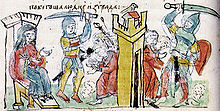Drewlanen
The Drewljanen or Drewlanen ( Ukrainian Деревляни, Russian Древляне) were an East Slavic tribe between the 7th and 12th centuries in Polesia in northern Ukraine .
Surname
The name Drewljanen is probably derived from the Slavic word drewo 'tree', 'wood'.
Possibly he was referring to the settlement area in wooded areas, in contrast to the Poljanen ( polje , field ') in less wooded areas.
area
The drevlians left numerous archaeological traces, such as remains of settlements, burial sites and fortifications (z. B. in today's cities Ovruch , Horodsk or Malyn ). The city of the prince of the Drewanen was Iskorosten, today's Korosten ; traces of old settlements can still be seen there.
Their neighboring tribes were the Polans in the east , the Volhynians and the Buschans in the west, and the Dregoviches in the north .
Economy and way of life
The Drewlanen had well developed agricultural knowledge and crafts. Fixed burial rituals testify to religious ideas about life in the afterlife, while the lack of weapons in the graves indicates a peaceful character of the Drewlanen. The finds of sickles , metal products , remnants of fabric and leather show that the Drewlanen practiced agriculture and mastered pottery, ironwork, weaving and tannery. The bones of domestic animals, including horses, are evidence of animal husbandry. Numerous products made of silver , bronze and chalcedony of foreign origin indicate participation in long-distance trade, while the lack of coins suggests bartering .
history

The Drewlanen stubbornly resisted any attempts to subordinate them to foreign rule. In 883, Oleg of Novgorod forced the Drewlanes to pay tribute to the Kievan Rus . In 907 the Drewlanes took part in the Kiev campaign against Byzantium . After Oleg's death, the Drewlyans refused to pay tribute to Kiev. Oleg's successor, Igor, tried to force them again, but the Drewlyans organized an uprising and killed him in 945.
Igor's widow Olga cruelly avenged her husband's death. She had the ambassadors of the Drewlyans buried alive, burned their capital, Iskorosten, and razed many cities to the ground. After the Drewlanes were subjugated, they incorporated their territories into the Kievan Rus.
Svyatoslav I , the son of Olga, made his second oldest son, Oleg, Prince of the Drewlyans in 970. Around 990, Svyatoslav , Oleg's nephew, became a prince.
The last mention of the Dravlanes in the chronicles is dated to 1136, when Prince Jaropolk II donated their territories to the Desjatinnaya Church in Kiev. In the 19th century there were still people who called themselves Drewlanen. The census of 1861 recorded almost 200,000 of them. However, they were later completely absorbed by the Ukrainian people.
literature
- BB Богуславский, В.В. Бурминов: Русь рюриковичей. Иллюстрированный исторический словарь (Russian)

